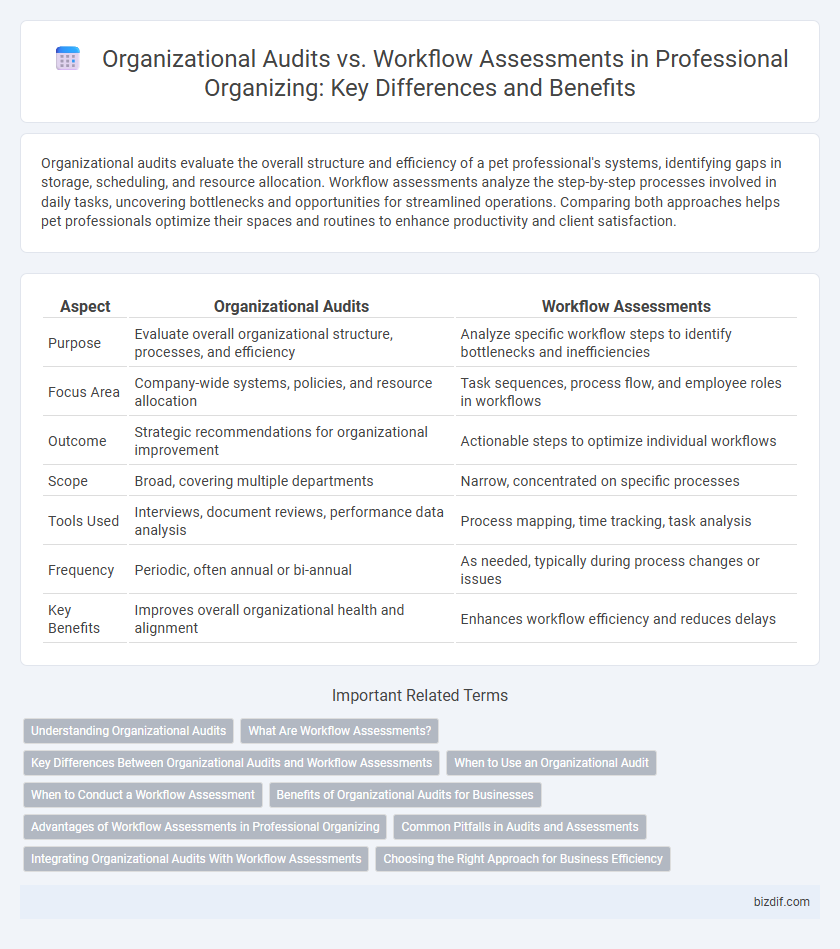Organizational audits evaluate the overall structure and efficiency of a pet professional's systems, identifying gaps in storage, scheduling, and resource allocation. Workflow assessments analyze the step-by-step processes involved in daily tasks, uncovering bottlenecks and opportunities for streamlined operations. Comparing both approaches helps pet professionals optimize their spaces and routines to enhance productivity and client satisfaction.
Table of Comparison
| Aspect | Organizational Audits | Workflow Assessments |
|---|---|---|
| Purpose | Evaluate overall organizational structure, processes, and efficiency | Analyze specific workflow steps to identify bottlenecks and inefficiencies |
| Focus Area | Company-wide systems, policies, and resource allocation | Task sequences, process flow, and employee roles in workflows |
| Outcome | Strategic recommendations for organizational improvement | Actionable steps to optimize individual workflows |
| Scope | Broad, covering multiple departments | Narrow, concentrated on specific processes |
| Tools Used | Interviews, document reviews, performance data analysis | Process mapping, time tracking, task analysis |
| Frequency | Periodic, often annual or bi-annual | As needed, typically during process changes or issues |
| Key Benefits | Improves overall organizational health and alignment | Enhances workflow efficiency and reduces delays |
Understanding Organizational Audits
Organizational audits provide a comprehensive evaluation of a company's overall structure, policies, and processes to identify inefficiencies and compliance gaps. These audits focus on assessing resource allocation, internal controls, and performance metrics to optimize operational effectiveness. Understanding organizational audits enables businesses to implement strategic improvements and enhance productivity across departments.
What Are Workflow Assessments?
Workflow assessments evaluate the efficiency and effectiveness of business processes by mapping tasks, identifying bottlenecks, and analyzing resource allocation. These assessments provide actionable insights to streamline operations, improve productivity, and reduce errors within an organization. Unlike organizational audits, which focus on compliance and overall structure, workflow assessments target specific task sequences to optimize day-to-day work performance.
Key Differences Between Organizational Audits and Workflow Assessments
Organizational audits evaluate the overall structure, policies, and resource allocation to ensure compliance and efficiency across departments, while workflow assessments concentrate specifically on analyzing and optimizing the step-by-step processes within teams to enhance productivity. Audits identify gaps in organizational controls and adherence to standards, whereas workflow assessments pinpoint bottlenecks, redundancies, and opportunities for process improvement. Both methods contribute to operational excellence but differ in scope, with audits providing a macro-level review and workflow assessments delivering a micro-level process analysis.
When to Use an Organizational Audit
An organizational audit is essential when a company needs a comprehensive evaluation of its internal structures, policies, and resource allocation to identify inefficiencies and compliance issues. It provides a thorough diagnosis of organizational health, including communication flow, employee performance, and management effectiveness. Use an organizational audit during periods of major change, regulatory reviews, or when strategic realignment is necessary to ensure the company operates optimally.
When to Conduct a Workflow Assessment
Conduct a workflow assessment when inefficiencies, bottlenecks, or redundancies hinder productivity within a team or department. This evaluation targets specific processes to identify obstacles affecting task completion, resource allocation, and overall operational flow. Workflow assessments are essential during periods of organizational change, technology implementation, or when aiming to optimize performance and employee satisfaction.
Benefits of Organizational Audits for Businesses
Organizational audits provide a comprehensive evaluation of a company's structure, processes, and resources, enabling identification of inefficiencies and compliance gaps. Businesses benefit from enhanced decision-making and resource allocation by uncovering hidden issues and optimizing operational workflows. This systematic review supports long-term growth, risk management, and improved overall performance.
Advantages of Workflow Assessments in Professional Organizing
Workflow assessments in professional organizing provide a dynamic evaluation of processes, identifying inefficiencies and bottlenecks that hinder productivity. Their advantage lies in enhancing task management and optimizing time allocation through tailored strategies, which boosts overall operational efficiency. These assessments enable clients to implement sustainable workflows, improving consistency and reducing stress in both personal and professional environments.
Common Pitfalls in Audits and Assessments
Organizational audits often suffer from incomplete data collection and lack of stakeholder involvement, leading to inaccurate representations of current processes. Workflow assessments frequently overlook hidden inefficiencies and employee feedback, causing missed opportunities for optimizing task sequences. Both audits and assessments require thorough analysis and clear communication to avoid these common pitfalls and ensure actionable outcomes.
Integrating Organizational Audits With Workflow Assessments
Integrating organizational audits with workflow assessments enhances overall efficiency by identifying gaps in both structural organization and operational processes. This combined approach provides a comprehensive evaluation of resource allocation, task management, and communication flows, enabling tailored strategies for optimizing workplace productivity. Leveraging insights from both audits supports continuous improvement and alignment with business objectives.
Choosing the Right Approach for Business Efficiency
Organizational audits evaluate the overall structure, policies, and resource allocation to identify inefficiencies across departments, while workflow assessments focus specifically on analyzing task sequences and process bottlenecks within teams. Selecting the right approach depends on the business's goals: audits provide a macro-level view of operational health, whereas workflow assessments deliver micro-level insights for process optimization. Integrating both methods can enhance decision-making, streamline operations, and boost productivity effectively.
Organizational audits vs workflow assessments Infographic

 bizdif.com
bizdif.com